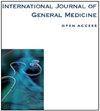Serum LOXL2 is Elevated and an Independent Biomarker in Patients with Coronary Artery Disease
IF 2.1
4区 医学
Q2 MEDICINE, GENERAL & INTERNAL
引用次数: 0
Abstract
Background: Arterial stiffness is associated with accelerated progression of atherosclerosis and plaque rupture. Lysyl oxidase-like 2 (LOXL2) plays a vital role in inflammatory responses, matrix deposition and arterial stiffness. This study assessed the correlation between the serum LOXL2 concentration and disease severity, inflammation, and endothelial dysfunction of coronary artery disease (CAD).Methods: The study included 143 CAD patients and 150 non-CAD patients who underwent coronary angiography. Medical records, demographic and clinical baseline parameters were collected. Serum LOXL2 levels were measured using an ELISA kit.
Results: CAD patients had higher serum LOXL2 levels than non-CAD patients, and LOXL2 levels were associated with severity of coronary lesions. Serum LOXL2 level was positively correlated with low-density lipoprotein cholesterol (LDL-C) (r=0.161, P=0.054), systolic blood pressure (SBP) (r=0.175, P=0.036), high-sensitivity C-reactive protein (hs-CRP) (r=0.177, P=0.035), intima-media thickness (IMT) (r=0.190, P=0.023), and brachial-ankle pulse wave velocity (baPWV) (r=0.203, P=0.015), while negatively associated with high-density lipoprotein cholesterol (HDL-C) (r=− 0.191, P=0.023) and flow-mediated dilation (FMD) (r=− 0.183, P=0.028) in CAD patients. Multivariate logistic regression showed that LOXL2 is independently correlated with LDL-C (OR=3.380; 95% CI=1.258– 9.082; P=0.016), hs-CRP (OR=10.988; 95% CI=1.962– 61.532; P=0.006), TC (OR=2.229; 95% CI=1.005– 4.944; P=0.049), IMT (OR=72.719; 95% CI=2.313– 2286.008; P=0.015), and baPWV (OR=1.002; 95% CI=1.001– 1.004; P=0.005) in CAD patients. The receiver operating characteristic (ROC) curve showed that the best cut-off for CAD as serum LOXL2 is 275.35 pg/mL, with sensitivity and specificity of 77.6% and 84%, respectively.
Conclusion: Our data demonstrated that LOXL2 could be a potential biomarker and independent risk factor for CAD patients.
血清 LOXL2 升高是冠状动脉疾病患者的独立生物标记物
背景:动脉僵化与动脉粥样硬化的加速进展和斑块破裂有关。类赖氨酸氧化酶 2(LOXL2)在炎症反应、基质沉积和动脉僵化中起着至关重要的作用。本研究评估了血清 LOXL2 浓度与冠状动脉疾病(CAD)的病情严重程度、炎症和内皮功能障碍之间的相关性:研究纳入了 143 名接受冠状动脉造影术的 CAD 患者和 150 名非 CAD 患者。收集了病历、人口统计学和临床基线参数。使用酶联免疫吸附试剂盒测定血清 LOXL2 水平:结果:CAD患者的血清LOXL2水平高于非CAD患者,LOXL2水平与冠状动脉病变的严重程度有关。血清 LOXL2 水平与低密度脂蛋白胆固醇(LDL-C)(r=0.161,P=0.054)、收缩压(SBP)(r=0.175,P=0.036)、高敏 C 反应蛋白(hs-CRP)(r=0.177,P=0.035)、内膜中层厚度(IMT)(r=0.190,P=0.023)和肱踝脉搏波速度(baPWV)(r=0.203,P=0.015)呈负相关,而与 CAD 患者的高密度脂蛋白胆固醇(HDL-C)(r=- 0.191,P=0.023)和血流介导的扩张(FMD)(r=- 0.183,P=0.028)呈负相关。多变量逻辑回归显示,LOXL2 与低密度脂蛋白胆固醇(OR=3.380;95% CI=1.258-9.082;P=0.016)、hs-CRP(OR=10.988;95% CI=1.962-61.532;P=0.006), TC (OR=2.229; 95% CI=1.005- 4.944; P=0.049), IMT (OR=72.719; 95% CI=2.313- 2286.008; P=0.015), and baPWV (OR=1.002; 95% CI=1.001- 1.004; P=0.005) in CAD patients.接收器操作特征曲线(ROC)显示,血清 LOXL2 作为 CAD 的最佳临界值为 275.35 pg/mL,敏感性和特异性分别为 77.6% 和 84%:我们的数据表明,LOXL2 可能是一种潜在的生物标记物,也是 CAD 患者的独立危险因素。
本文章由计算机程序翻译,如有差异,请以英文原文为准。
求助全文
约1分钟内获得全文
求助全文
来源期刊

International Journal of General Medicine
Medicine-General Medicine
自引率
0.00%
发文量
1113
审稿时长
16 weeks
期刊介绍:
The International Journal of General Medicine is an international, peer-reviewed, open access journal that focuses on general and internal medicine, pathogenesis, epidemiology, diagnosis, monitoring and treatment protocols. The journal is characterized by the rapid reporting of reviews, original research and clinical studies across all disease areas.
A key focus of the journal is the elucidation of disease processes and management protocols resulting in improved outcomes for the patient. Patient perspectives such as satisfaction, quality of life, health literacy and communication and their role in developing new healthcare programs and optimizing clinical outcomes are major areas of interest for the journal.
As of 1st April 2019, the International Journal of General Medicine will no longer consider meta-analyses for publication.
 求助内容:
求助内容: 应助结果提醒方式:
应助结果提醒方式:


